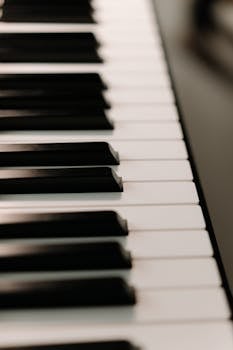Synthesizer Knobs
As an Amazon Services LLC Associates Program participant, we earn advertising fees by linking to Amazon, at no extra cost to you.
Types of Knobs and Their Functions
Here’s a look at the various knobs found on synthesizers and their roles in sound shaping. Each knob plays a pivotal part in crafting your unique sound.
- 1- Oscillator Knobs: These control the pitch and waveform type. They define the basic sound foundation.
- 2- Filter Knobs: They shape the sound’s timbre by cutting off frequencies. Adjusting them can make a sound bright or dull.
- 3- Envelope Knobs: These manage the sound’s attack, decay, sustain, and release. They dictate how a sound evolves over time.
- 4- LFO Knobs: Low-Frequency Oscillator knobs modulate parameters like pitch or filter. They add movement and depth to sounds.
- 5- Resonance Knobs: They enhance certain frequencies at the filter cutoff point. This can create a pronounced, ringing quality.
- 6- Volume Knobs: Simple yet essential, these control the output level. They can drastically change the mix of your sound.
- 7- Pan Knobs: They determine the stereo placement of sounds. Adjusting pan can create a wider soundstage in your mix.
- 8- Modulation Knobs: These control the depth and speed of modulation effects. They can make sounds feel alive and dynamic.
- 9- MIDI Control Knobs: These can be assigned to various parameters in your DAW. They offer flexibility in live performance and studio sessions.
- 10- Touch-sensitive Controls: A new wave of synthesizers uses touch for sound manipulation. They allow for expressive playing styles and real-time adjustments.
Understanding the User Experience with Tactile Controls
Synthesizer knobs play a pivotal role in shaping the sound experience. Here’s how they impact user interaction and creativity.
- Knobs provide immediate tactile feedback. You can feel the adjustments you’re making.
- Each knob has a distinct function. From modulation to filter settings, they guide your sound design.
- Familiarity with knobs enhances creativity. The more you know, the more you can experiment.
- Alternative controls are emerging. Touch-sensitive interfaces are gaining traction, offering new ways to interact.
- Hybrid synthesizers are the future. They merge analog warmth with digital flexibility, creating exciting possibilities.
- User experience varies with design. Some synths are intuitive, while others may feel overwhelming at first.
- Experimentation is key. Don’t be afraid to twist knobs randomly; you might stumble upon something amazing!
Essential Functions of Common Knobs
Exploring the key roles of synthesizer knobs and how they shape sound.
- Knobs control various parameters like pitch and filter frequency. They allow for real-time adjustments, making sound design intuitive.
- Each knob has a unique function. For instance, the resonance knob affects how much of the signal is allowed to pass through the filter.
- Tactile feedback from knobs enhances creativity. The physical interaction encourages experimentation, leading to unexpected sonic outcomes.
- Understanding knob functions is key to mastering a synth. Familiarity with your instrument unlocks its full potential.
- Knobs can be used for modulation. They can control effects like vibrato or tremolo, adding depth to your sound.
- Some synths also feature touch-sensitive controls. These modern interfaces allow for dynamic performance styles, enhancing expressiveness.
How Different Controls Shape Sound
Knobs are the magic wands of synthesizers. They let us shape sound in ways that feel personal and intuitive. Each twist and turn can lead to a completely different sonic landscape.
Most people think that all knobs serve the same purpose. But I believe that each knob has a unique personality. For instance, a filter knob can either cut harsh frequencies or add warmth, depending on how you use it. The interaction with these controls is where true creativity lies.
Many synth enthusiasts swear by the tactile feel of knobs. They argue that nothing beats the physical connection when crafting sounds. I get that, but I think we should embrace digital interfaces too. They can offer flexibility and new ways to express creativity.
Touch-sensitive controls are gaining traction. They allow for fluid movement and can respond to gestures, opening up new performance possibilities. Imagine shaping sound with a swipe! It’s that simple.
Exploring alternative control methods can lead to unexpected results. While many stick to traditional knobs, I find that experimenting with generative processes can yield fascinating outcomes. It’s about breaking the mold and seeing where the sound takes you.
According to Pianote, “We don’t need to have our PhD in knob-turning to use a keyboard.” This resonates with me. It’s about feeling the music, not just knowing the science.
So, the next time you sit down with a synth, think about the knobs. They’re not just controls; they’re gateways to your creativity. Use them wisely!
The Future of Synthesizer Interfaces
Most people think knobs are the only way to control synthesizers. I see it differently. Touch-sensitive interfaces are the future. They offer a dynamic and fluid way to interact with sound.
Imagine performing live and using gestures to manipulate sounds. It’s that simple! This shift can lead to more expressive performances and unexpected sonic outcomes.
Many artists still cling to traditional knobs. But why limit creativity? Using alternative controls can open doors to new musical experiences. This could change how we perceive sound.
As technology evolves, hybrid synthesizers are emerging. They blend analog warmth with digital flexibility. This combination can create sounds we’ve never heard before. Musicians can explore a broader range of sonic possibilities.
Incorporating AI into synthesizer interfaces is another exciting frontier. Imagine a synth that learns your preferences and adapts in real-time! This could transform how we approach sound design.
As I see it, the future is about embracing change. The more we experiment with different interfaces, the richer our musical landscape becomes. Let’s not forget, innovation drives creativity.
According to Native Instruments, “ADSR envelopes are a vital building block in electronic sound creation.” This highlights the need for evolving how we interact with these fundamental elements.
In conclusion, the future of synthesizer interfaces is bright. It’s time to push boundaries and redefine how we create music.
The Importance of Knobs in Synthesizers
Knobs are the heartbeat of synthesizers. They allow musicians to shape sounds in real-time. Without them, sound design would feel sterile.
Each knob serves a unique purpose. Some control frequency modulation, while others adjust filter resonance. The tactile feedback is what makes sound manipulation so engaging.
Many believe that advanced software can replace knobs. I disagree. There’s something magical about physically turning a knob.
Using knobs can feel like a conversation with the instrument. You twist, you turn, and the sound responds. This interaction fuels creativity.
Some synths even feature alternative controls, like touch-sensitive interfaces. While these are innovative, they lack the intimacy of traditional knobs.
Experimenting with knobs can lead to unexpected sounds. It’s a journey, not just a destination.
Max McAllister from Produce Like A Pro states, “Synths are an electronic musical instrument which can produce sound by generating different signals.” This underscores the versatility knobs bring to the table. Read more about synthesizers here.
In my experience, mastering the knobs opens up a world of possibilities. It’s about finding your unique sound.
So, next time you sit down with a synth, embrace those knobs. They are your best friends in sound exploration.
This model-based active learning approach learns high-level knobs on certain classes of target concepts faster than several baselines.
Active Learning of Intuitive Control Knobs for Synthesizers Using …
May 21, 2012 … Patchwork: Multi-User Network Control of a Massive Modular Synthesizer … knobs and LEDs, and streams the resultant audio. In a typical …
Patchwork: Multi-User Network Control of a Massive Modular …
Intuitive Control Knobs; Synthesizers; Sound Synthesis; … They are like macro knobs that control the low-level synthesizer parameters in region (2).
Active Learning of Intuitive Control Knobs for Synthesizers Using …
Nov 10, 2019 …Synthesizers went mainstream in the hands of pioneers Robert Moog, who used knobs and switches with an organ-style keyboard as the main …
Lafayette-Inspired Synthesizer Wins U.S. Patent · News · Lafayette …
Exploring Alternative Control Methods
Most people think knobs are the only way to control synthesizers. I believe there’s a whole world of alternative methods out there. Touch-sensitive interfaces and gesture-based controls are leading the charge. These modern approaches can feel way more intuitive and fluid.
Imagine performing live and manipulating sounds with just a wave of your hand. It’s that simple! This kind of control opens up new creative avenues. You can express yourself in ways traditional knobs can’t match.
Some might argue that knobs provide a tactile experience that can’t be replicated. But I think the unpredictability of touch controls adds excitement. It can lead to unexpected sonic outcomes that are refreshing and innovative.
Plus, these alternatives can make music creation more accessible. You don’t need to be a knob-twiddling expert to create amazing sounds. Just think about it: a beginner could dive right in and start experimenting without the steep learning curve.
As technology evolves, I see hybrid models blending both worlds. These synths combine the warmth of analog with the versatility of digital. They can adapt in real-time, responding dynamically to your performance. This fusion is where the magic happens!
Let’s not forget about the exciting potential of generative processes. By using randomization tools, musicians can explore sound creation without the constraints of traditional settings. This can lead to a rich tapestry of unexpected musical experiences.
In conclusion, while knobs have their place, alternative control methods are changing the game. They offer fresh perspectives and new ways to engage with sound. So why not embrace the future and experiment with these innovative approaches?
Rogan RB Knobs · Synth Pointer – Silver Inlay Disk Spares · Tall Trimmer Toppers · Knob Knobs – 6.35mm Round Shaft Knobs · Noise Engineering Knobs · 'Erica Synths' …
Nov 14, 2022 … … r/synthesizers – Cleaning an Arturia Minibrute knobs of sticky residue? Page 1 (Current page) Page 2. Page 3. Page 4.
Cleaning an Arturia Minibrute knobs of sticky residue? : r/synthesizers
Nov 15, 2016 … The MS range knobs are great too – and indeed – the knobs on the Trident Mark1 are exquisite – and thoug I own a Monopoly and Trident Mark2, I …
Which synth do you think has the nicest knobs ? – Page 2 – Vintage …
Jun 3, 2022 … If you load a preset on the thing and then tweak a knob or move a fader, does the value that control represents jump immediately to whatever position the …
How does a synth with knobs and faders load presets? : r/synthesizers
Apr 1, 2021 … Just wanted to show how you edit sounds on the Sequential Multi-Trak. Though it only has one knob to edit parameters with, it is still one …
Sequential Multi-Trak – Editing a Synth with One Knob? – YouTube
What are the common functions of synthesizer knobs?
Knobs on synthesizers are like the magic wands of sound design. They control everything from pitch to filter resonance. Each knob has a specific function that can drastically change the sound.
For instance, the filter knob shapes the timbre, while the modulation knob adds movement. These controls empower musicians to craft unique sonic experiences.
Most people think knobs are just for tweaking settings, but I see them as a gateway to creativity. Experimenting with different knob positions can lead to unexpected and exciting sounds.
Some synths even have touch-sensitive interfaces. This modern twist allows for a more dynamic performance. It’s that simple—interaction can lead to innovation!
As Justin Stanton from Pianote says, “We don’t need to have our PhD in knob-turning to use a keyboard.” This just shows how accessible sound design can be!
Finally, consider using knobs in unconventional ways. Most artists stick to traditional methods, but I think exploring generative processes can unlock new sonic realms.
How do knobs compare with touch-sensitive interfaces?
Most people think knobs are the best way to control synthesizers. I think touch-sensitive interfaces can actually offer more flexibility. They allow for fluid movements that knobs just can’t replicate.
Knobs give you that satisfying tactile feedback. But let’s be real: they can also limit your creativity. Touch interfaces can respond to gestures, opening up new possibilities.
According to Diego from zZounds, knobs are essential for shaping sounds. But I believe that as technology evolves, we should embrace innovative controls.
Many synths now include both options, which is exciting! Imagine blending the precision of knobs with the expressiveness of touch. It’s a whole new world of sound exploration.
In a live setting, touch interfaces can lead to spontaneous creativity. You can manipulate sounds in real-time, creating unpredictable and dynamic performances. This is something that traditional knob setups struggle to achieve.
Can synthesizers be used as MIDI controllers?
Absolutely! Synthesizers can double as MIDI controllers. This means they can send MIDI signals to other devices or software, allowing for versatile control.
Many musicians think MIDI controllers are just keyboards. But I believe synthesizers bring a unique flair. They offer the tactile experience of knobs and sliders, which can inspire creativity.
According to Burton Acoustix, using synthesizers for MIDI control is extremely gratifying. It’s not just about playing notes; it’s about shaping sound in real-time!
Some might argue that traditional MIDI controllers are simpler. But I think the complexity of synthesizers adds depth. They allow for more expressive performances, especially when you dive into modulation and effects.
Most people believe that sticking to basic MIDI controllers is safer. However, I think embracing synthesizers as MIDI controllers opens new avenues. It encourages experimentation and pushes the boundaries of sound.
What are the benefits of using alternative control methods?
Most people think knobs are the only way to control synthesizers. I believe alternative control methods can open up a whole new world of sound exploration. Touch-sensitive interfaces and gesture-based controls can lead to spontaneous creativity and unexpected results.
Imagine performing live and using your hands to shape the sound dynamically. It’s that simple! This fluid interaction can make your music feel more alive and engaging.
Many musicians overlook the potential of these modern approaches. According to Diego from zZounds, synthesizers can be incredibly gratifying when used as MIDI controllers. But I think going beyond traditional knobs can truly elevate your performance.
Exploring these alternative methods can lead to unique sonic textures that knobs alone might not achieve. I find that embracing unpredictability in sound design adds excitement and freshness to my music.
As Max McAllister from Produce Like A Pro suggests, synthesizers are versatile. Why limit yourself to just knobs when you can experiment with various control styles? Embrace the change and see where it takes your sound!
Knobs are the heartbeat of synthesizers. They let you sculpt sounds in real time. I love the tactile feedback they offer; it’s pure magic!
Most people think knobs are just for tweaking settings. But I believe they are gateways to creativity. Each turn can lead to unexpected sonic discoveries.
Some argue that touch-sensitive interfaces are the future. I disagree! Knobs give a physical connection that feels alive.
According to Max McAllister from Produce Like A Pro, “Synths are an electronic musical instrument which can produce sound by generating different signals.” This highlights how knobs play a pivotal role in that generation.
Exploring alternative control methods can be exciting. But nothing beats the satisfaction of a well-turned knob!
Knobs are the heartbeat of synthesizers. They transform sound in real-time. Experimentation is key!
Most people think knobs are just for control. But I believe they are gateways to creativity. The tactile feedback connects you to the sound.
Many synth enthusiasts overlook alternative control methods. Touch-sensitive interfaces can offer new dimensions. They allow for spontaneous expression that knobs can’t always provide.
According to Max McAllister from Produce Like A Pro, “Synths are an electronic musical instrument which can produce sound by generating different signals.” This underscores the power of knobs in shaping those signals.
Embrace the knobs! They can lead to unexpected sonic discoveries. Check out this guide for more insights.
Most people think knobs are the only way to control synthesizers. But I believe that exploring alternative controls can spark creativity like never before. Imagine using gesture-based systems or touch-sensitive interfaces that react to your movements!
These modern approaches can make sound design feel more organic. You’re not just tweaking knobs; you’re performing! It’s that simple.
As I’ve seen in my own experience, these alternatives can lead to unexpected sonic outcomes. They push you out of your comfort zone and into new musical territories.
According to Max McAllister from Produce Like A Pro, “Synths are an electronic musical instrument which can produce sound by generating different signals.” This opens the door to limitless possibilities.
So, why stick to traditional methods? Embrace the future and let your creativity flow!
Most people think knobs are the only way to control synthesizers. I think exploring touch-sensitive and gesture-based controls opens a world of creativity.
These modern interfaces allow for fluid, intuitive performances. They can add unpredictability, making live shows more dynamic.
It’s that simple! By embracing these new methods, you can create sounds that truly stand out.
According to Pianote, “We don’t need to have our PhD in knob-turning to use a keyboard.” This shows that innovation in controls can simplify the process.
Experimentation leads to unique sound design. So, don’t just stick with traditional knobs; explore!
As an Amazon Services LLC Associates Program participant, we earn advertising fees by linking to Amazon, at no extra cost to you.








